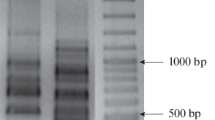Abstract
The genetic systems responsible for naphthalene and phenanthrene catabolism have been analyzed in the five strains of Burkholderia sp. isolated from soil samples (West Siberia) contaminated by heavy residual fuel and in the laboratory collection strain Burkholderia sp. BS3702 isolated from soil samples of the coke gas plant (Vidnoe, Moscow oblast). The results of this work demonstrate that naphthalene and phenanthrene degradation in the above strains is encoded by the sequences not homologous to the classical nah genes of pseudomonades. In the Burkholderia sp. BS3702 strain, the initial stages of phenanthrene degradation and the subsequent stages of salicylate degradation are controlled by the sequences of different evolutionary descent (phn and nag genes).
Similar content being viewed by others
References
Habe, H. and Omori, T., Genetics of polycyclic aromatic hydrocarbons metabolism in diverse aerobic strains, Biosci. Biotechnol. Biochem., 2003, vol. 67, pp. 225–243.
Zhou, N.Y., Fuenmayor, S.L., and Williams, P.A., nag genes of Ralstonia (formerly Pseudomonas) sp. strain U2 encoding enzymes for gentisate catabolism, J. Bacteriol., 2001, vol. 183, pp. 700–708.
Jeon, C.O., Park, M., Ro, H.S., et al., The naphthalene catabolic (nag) genes of Polaromonas naphthalenivorans CJ2: evolutionary implications for two gene clusters and novel regulatory control, Appl. Environ. Microbiol., 2006, vol. 72, pp. 1086–1095.
Mueller, J.G., Devereux, R., Santavy, D.L., et al., Phylogenetic and physiological comparisons of PAH-degrading bacteria from geographically diverse soils, Antonie van Leeuwenhoek, 1997, vol. 71, pp. 329–343.
Laurie, A.D. and Lloyd-Jones, G., The phn genes of Burkholderia sp. strain RP007 constitute a divergent gene cluster for polycyclic aromatic hydrocarbon catabolism, J. Bacteriol., 1999, vol. 181, pp. 531–540.
Laurie, A.D. and Lloyd-Jones, G., Conserved and hybrid meta-cleavage operons from PAH-degrading Burkholderia RP007, Biochem. Biophys. Res. Commun., 1999, vol. 262, pp. 308–314.
Izmalkova, T.Yu., Diversity of genetic systems of naphthalene catabolism in fluorescent pseudomonad strains, Cand. Sci. (Biol.) Dissertation, Pushchino: Skryabin Inst. Biochem. Physiol. Microorganisms, 2004, p. 129.
Maniatis, T., Fritsch, E.F., and Sambrook, J., Molecular Cloning: A Laboratory Manual, Cold Spring Harbor: Cold Spring Harbor Lab., 1982.
Evans, C.G.T., Herbert, D., and Tempest, D.B., The continuous cultivation of microorganisms: 2. Construction of a chemostat, Methods Microbiol., 1970, vol. 2, pp. 277–327.
Ausubel, F.M., Brent, R., Kingston, R.E., et al., Shot Protocols in Molecular Biology, Wiley, 4th ed.
Dombek, P.E., Johnson, L.K., Zimmerley, S.T., and Sadowsky, M.J., Use of repetitive DNA sequences and the PCR to differentiate Escherichia coli isolates from human and animal sources, Appl. Environ. Microbiol., 2000, vol. 66, pp. 2572–2577.
Weisburg, W.G., Barnes, S.M., Pelletier, D.A., and Lane, D.J., 16S ribosomal DNA amplification for phylogenetic study, J. Bacteriol., 1991, vol. 73, pp. 697–703.
Ferrero, M., Llobet-Brossa, E., Lalucat, J., et al., Coexistence of two distinct copies of naphthalene degradation genes in Pseudomonas strains isolated from the Western Mediterranean region, Appl. Environ. Microbiol., 2002, vol. 68, pp. 957–962.
Izmalkova, T.Yu., Mavrodi, D.V., Sokolov, S.L., et al., Molecular classification of IncP-9 naphthalene degradation plasmids, Plasmid, 2006, vol. 56, pp. 1–10.
Wikstrom, P., Wiklund, A., Andersson, A.C., and Forsman, M., DNA recovery and PCR quantification of catechol-2,3-dioxygenase genes from different soil types, J. Biotechnol., 1996, vol. 52, pp. 107–120.
Izmalkova, T.Yu., Sazonova, O.I., Sokolov, S.L., et al., The P-7 incompatibility group plasmids responsible for biodegradation of naphthalene and salicylate in fluorescent pseudomonads, Mikrobiologiya, 2005, vol. 74, no. 3, pp. 342–348.
Laurie, A.D. and Lloyd-Jones, G., Quanification of phnAc and nahAc in contaminated New Zealand soils by competitive PCR, Appl. Environ. Microbiol., 2000, vol. 66, pp. 1814–1817.
Balashova, N.V., Kosheleva, I.A., Golovchenko, N.P., and Boronin, A.M., Phenanthrene metabolism by Pseudomonas and Burkholderia strains, Proc. Biochem., 1999, vol. 35, pp. 291–296.
Balashova, N.V., Phenanthrene and naphthalene degradation by Pseudomonas and Burkholderia bacteria, Cand. Sci. (Biol.) Dissertation, Pushchino: Skryabin Inst. Biochem. Physiol. Microorganisms, 2000, p. 117.
Van de Peer, Y. and De Wachter, R., TREECON for Windows: a software package for the construction and drawing of evolutionary trees for the Microsoft Windows environment, Comput. Appl. Biosci., 1994, vol. 10, pp. 569–570.
Wilson, M.S., Herrick, J.B., Jeon, C.O., et al., Horizontal transfer of phnAc dioxygenase genes within one of two phenotypically and genotypically distinctive naphthalene-degrading guilds from adjacent soil environments, Appl. Environ. Microbiol., 2003, vol. 69, pp. 2172–2181.
Seo, J.S., Keum, Y.S., Hu, Y., et al., Degradation of phenanthrene by Burkholderia sp. C3: initial 1,2- and 3,4-dioxygenation and meta- and ortho-cleavage of naphthalene-1,2-diol, Biodegradation, 2007, vol. 18, pp. 123–131.
Tittabutr, P., Cho, I.K., and Li, Q.X., Phn and Nag-like deoxygenizes metabolize polycyclic aromatic hydrocarbons in Burkholderia sp. C3, Biodegradation, 2011, vol. 22, pp. 1119–1133.
Author information
Authors and Affiliations
Corresponding author
Additional information
Original Russian Text © T.Yu. Izmalkova, O.I. Sazonova, I.A. Kosheleva, A.M. Boronin, 2013, published in Genetika, 2013, Vol. 49, No. 6, pp. 703–711.
Rights and permissions
About this article
Cite this article
Izmalkova, T.Y., Sazonova, O.I., Kosheleva, I.A. et al. Phylogenetic analysis of the genes for naphthalene and phenanthrene degradation in Burkholderia sp. strains. Russ J Genet 49, 609–616 (2013). https://doi.org/10.1134/S1022795413060033
Received:
Published:
Issue Date:
DOI: https://doi.org/10.1134/S1022795413060033




